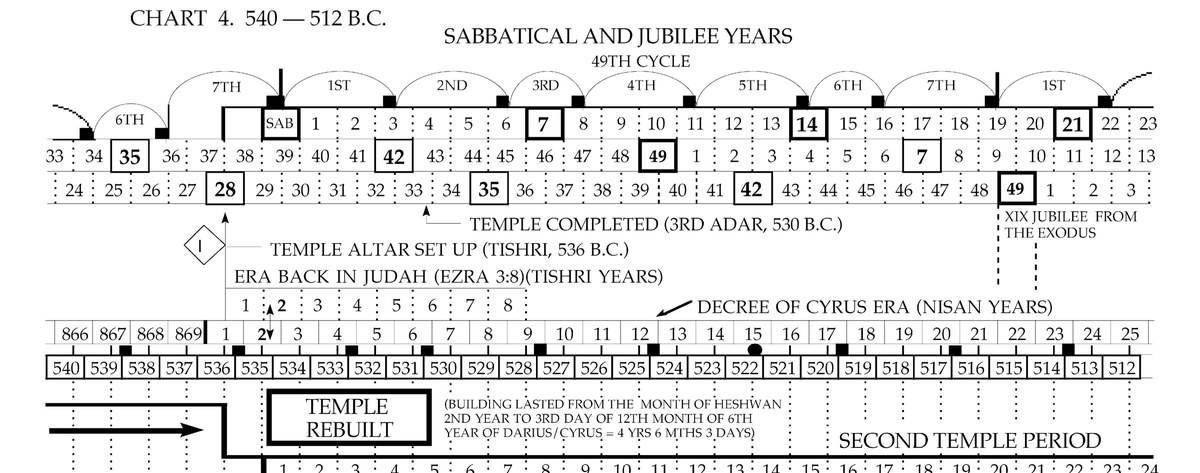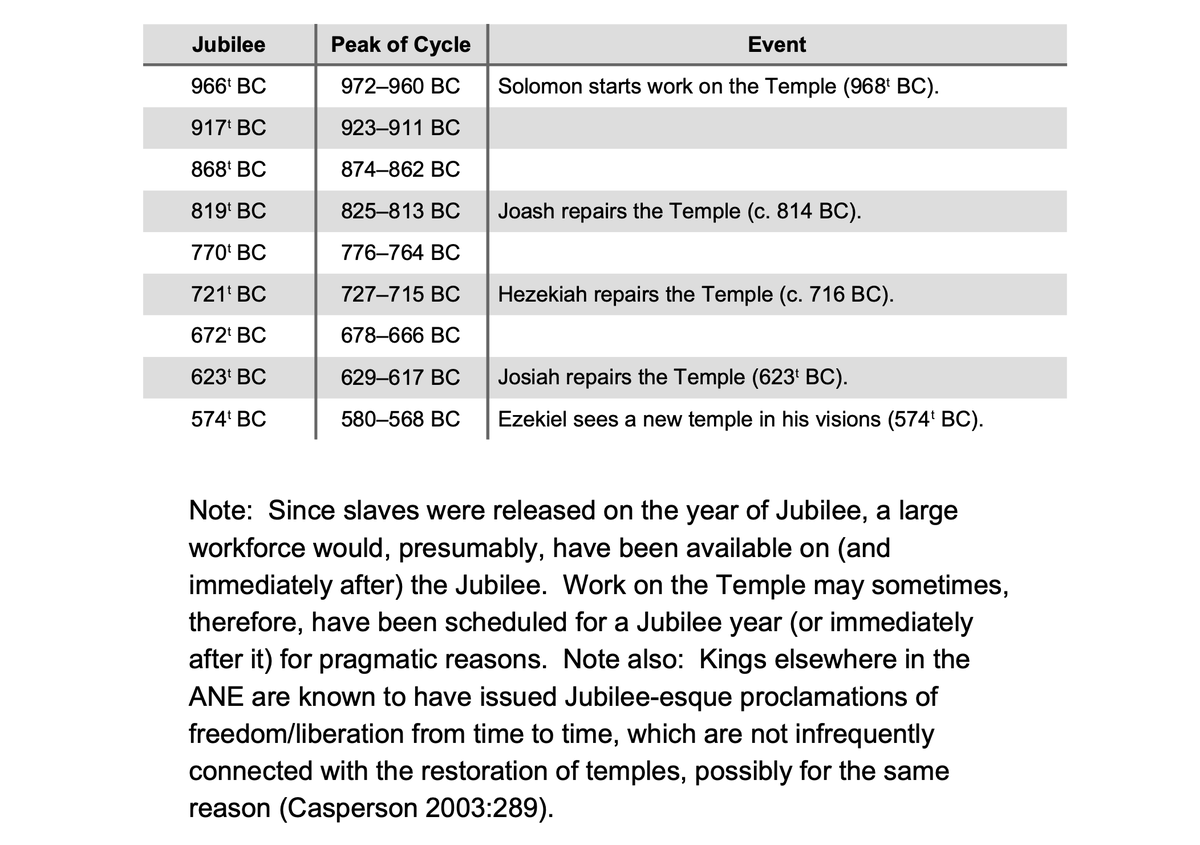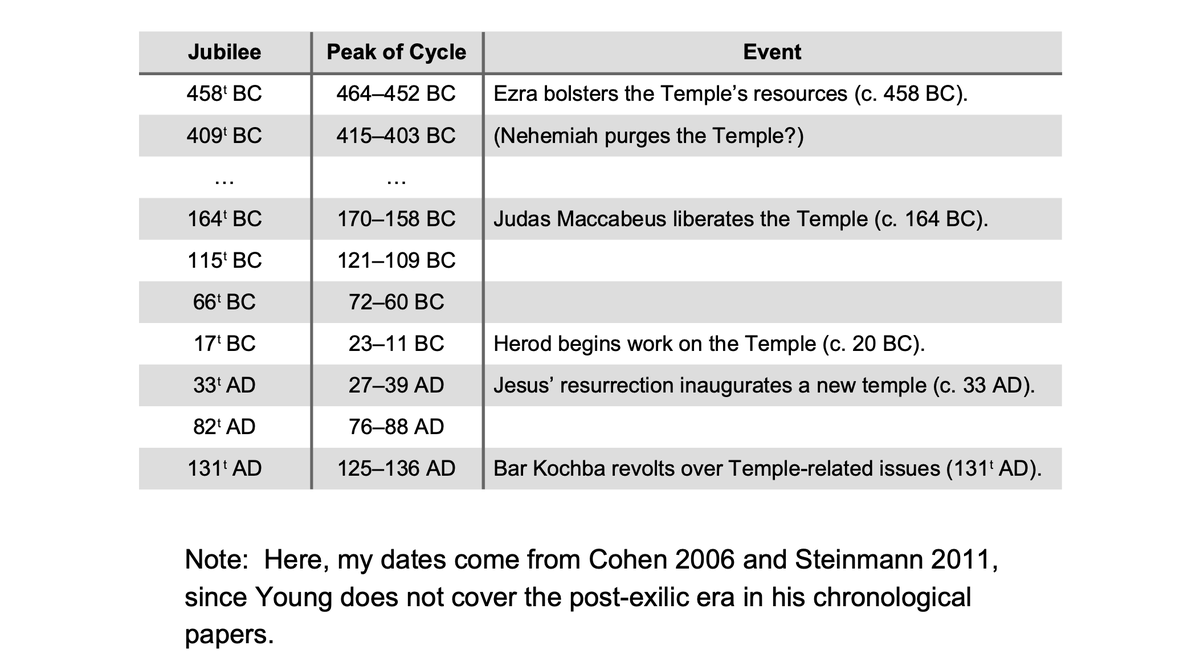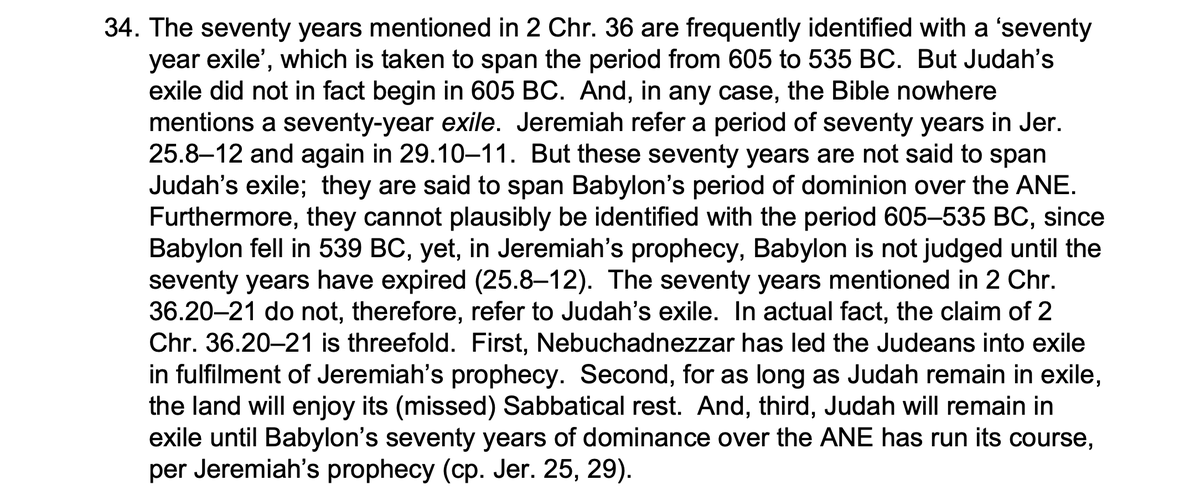THREAD: Strange Times call for Strange Threads.
Remarkably, I’ve been asked to include more (not less) chronology in my threads.
And so, with that extraordinary fact in mind, please join me in a final journey into the world of the Jubilee calendar.
Should any questions arise:
Remarkably, I’ve been asked to include more (not less) chronology in my threads.
And so, with that extraordinary fact in mind, please join me in a final journey into the world of the Jubilee calendar.
Should any questions arise:
In previous threads, I’ve suggested a start and end date for Israel’s (pre-exilic) Jubilee cycle. Specifically, I’ve argued for:
 https://abs.twimg.com/emoji/v2/... draggable="false" alt="🔹" title="Kleine blaue Raute" aria-label="Emoji: Kleine blaue Raute"> a 1406 BC entry into Canaan, and
https://abs.twimg.com/emoji/v2/... draggable="false" alt="🔹" title="Kleine blaue Raute" aria-label="Emoji: Kleine blaue Raute"> a 1406 BC entry into Canaan, and
 https://abs.twimg.com/emoji/v2/... draggable="false" alt="🔹" title="Kleine blaue Raute" aria-label="Emoji: Kleine blaue Raute"> a 17th Jubilee observance in 574 BC, in the year of Ezekiel’s final vision (cp. Ezek. 40.1).
https://abs.twimg.com/emoji/v2/... draggable="false" alt="🔹" title="Kleine blaue Raute" aria-label="Emoji: Kleine blaue Raute"> a 17th Jubilee observance in 574 BC, in the year of Ezekiel’s final vision (cp. Ezek. 40.1).
For details, see the links below:
https://twitter.com/JamesBejon/status/1258900687460728833
https://twitter.com/JamesBejo... href=" https://twitter.com/JamesBejon/status/1260338327775051786">https://twitter.com/JamesBejo... https://twitter.com/JamesBejon/status/1264273783185182726">https://twitter.com/JamesBejo...
https://twitter.com/JamesBejon/status/1258900687460728833
The Jubilee cycle, however, is not merely an object of lonely chronologers’ fascination (though it is at least that).
Its rhythm/periodicity has left a mark on Biblical history.
Its rhythm/periodicity has left a mark on Biblical history.
To appreciate it, however, we first need to take a step back and consider the nature of Israel’s calendar more generally.
Israel’s calendar is not simply a way to measure time.
It imbues particular periods of time with particular significance.
The days of the week comes to a climax in the Sabbath.
The weeks of the month come to a climax at the end of the second week—i.e., 14th day of the month—,
It imbues particular periods of time with particular significance.
The days of the week comes to a climax in the Sabbath.
The weeks of the month come to a climax at the end of the second week—i.e., 14th day of the month—,
since the moon waxes for two weeks and wanes for two weeks,
which imbues the 14th day of each month (when the feasts of Passover and Tabernacles take place) with special significance.
And the months of the year come to their climax in the 7th month (at Rosh ha-Shanah),
which imbues the 14th day of each month (when the feasts of Passover and Tabernacles take place) with special significance.
And the months of the year come to their climax in the 7th month (at Rosh ha-Shanah),
when the bulk/luxuries of the harvest are gathered in,
at which point three major holy days occur in quick succession (Trumpets, Atonement, and Tabernacles).
at which point three major holy days occur in quick succession (Trumpets, Atonement, and Tabernacles).
As such, the flow of time in Israel is non-uniform.
Time flows up to the 7th month of the year,
where it momentarily pauses before it flows down into the latter months of the year.
Time flows up to the 7th month of the year,
where it momentarily pauses before it flows down into the latter months of the year.
And, significantly, the Jewish people do likewise. In the 7th month, they flow up to Jerusalem (to celebrate the feast of Tabernacles),
where they remain for seven days before they return to their hometowns.
where they remain for seven days before they return to their hometowns.
Longer-term structures are also built into the Hebrew calendar.
If the 7th month marks the pinnacle of the year, then the 7th year marks the pinnacle of a week of years.
If the 7th month marks the pinnacle of the year, then the 7th year marks the pinnacle of a week of years.
It is a year of ‘release’ (שמיטה)—a time when slaves and debts are (temporarily) ‘released’ (Deut. 15) in anticipation of a greater (divinely-enacted) release to come.
And, if the Sabbatical year marks the pinnacle of each week of years,
And, if the Sabbatical year marks the pinnacle of each week of years,
then the year of Jubilee marks the pinnacle of each seven weeks of years...
...and hence provides an even more pronounced foreshadow of the release to come (cp. Dan. 9.24–27).
...and hence provides an even more pronounced foreshadow of the release to come (cp. Dan. 9.24–27).
As René Padilla writes, ‘(The Jubilee is)…a sort of institutionalised exodus in which…the experience of liberation from slavery is renewed and a new day of justice and peace dawns’ (Padilla 1996:22).
Given the momentous nature of the Jubilee year, the Jubilee’s day of Atonement would have been an immensely important event,
which the Israelites would no doubt have anticipated with great excitement.
which the Israelites would no doubt have anticipated with great excitement.
Israel’s temple—the focal-point of the Yom Kippur ritual when the Jubilee was announced (Lev. 25)—would have become a hub of activity and anticipation as the Jubilee drew near—a fact which appears to be left a mark on Biblical history.
As Lee Casperson has observed, at the peak of each Jubilee cycle, the Temple becomes the focus of many kings’ attention (Casperson 2003),
as is shown in the table below. (My dates for Joash and Hezekiah’s reigns come from Young 2005:246.)
as is shown in the table below. (My dates for Joash and Hezekiah’s reigns come from Young 2005:246.)
A similar table can be produced for the period from 458t BC onwards,
which is when Ezra is said to have reinstituted a Jubilee cycle in Israel (Seder Olam 30).
which is when Ezra is said to have reinstituted a Jubilee cycle in Israel (Seder Olam 30).
JUDAH’S EXILE
Before I finish up, I’d like to proffer one more line of evidence for my proposed reconstruction of Israel’s Sabbatico-Jubilee cycle,
namely the calculation inherent in the duration of Judah’s exile.
Before I finish up, I’d like to proffer one more line of evidence for my proposed reconstruction of Israel’s Sabbatico-Jubilee cycle,
namely the calculation inherent in the duration of Judah’s exile.
In 2 Chronicles 36.17–21, the fall and exile of Jerusalem is described.
Since ‘the land’ has not been granted its appointed Sabbatical years, the Babylonians are sent to wage war against Jerusalem (36.17–20)...
Since ‘the land’ has not been granted its appointed Sabbatical years, the Babylonians are sent to wage war against Jerusalem (36.17–20)...
...and the Judahites are ultimately borne away into exile (per the promise of Lev. 26).
In their absence, the land enjoys its missed years of Sabbatical rest,
In their absence, the land enjoys its missed years of Sabbatical rest,
which it completes at the same time as Babylon’s seventy years of dominance over the ANE are complete (cp. Jer. 25.8–12, 29.10–11).
How many Sabbatical years Judah misses prior to the invasion of the Babylonians is not stated in 2 Chronicles 36 (or anywhere else).
How many Sabbatical years Judah misses prior to the invasion of the Babylonians is not stated in 2 Chronicles 36 (or anywhere else).
The Babylonians invaded in 590t/589t BC (where ‘t’ signifies a Tishri-year, i.e., an autumn-to-autumn year).
Jerusalem fell in the summer of 587 BC.
And Babylon’s seventy years of dominance came to an end in October 539 = c. the 8th month of 539/538 BC (Young 2004).
Jerusalem fell in the summer of 587 BC.
And Babylon’s seventy years of dominance came to an end in October 539 = c. the 8th month of 539/538 BC (Young 2004).
As a result of Babylon’s intervention, then, the land of Judah enjoyed 49 Tishri-years’ worth of rest (from 587t/586t through to 539t/538t BC inclusive),
which suggests Judah failed to observe 49 Sabbatical years.
which suggests Judah failed to observe 49 Sabbatical years.
Suppose, then, as an experiment, we rewind 49 Sabbatical years from 590t/589t BC, when the Babylonians laid siege to Jerusalem.
Where do we end up?
Well, the first Sabbatical year would be 595t/594t, and the 49th would be 931t/930t BC,
Where do we end up?
Well, the first Sabbatical year would be 595t/594t, and the 49th would be 931t/930t BC,
which coincides with a significant moment in Judah’s history.
971t/970t BC was Solomon’s 1st year,
which makes 932t/931t his 40th year and (simultaneously) Rehoboam’s 1st year (Young 2005) and, as such, the moment when Judah was born as a nation (1 Kgs. 11–12).
971t/970t BC was Solomon’s 1st year,
which makes 932t/931t his 40th year and (simultaneously) Rehoboam’s 1st year (Young 2005) and, as such, the moment when Judah was born as a nation (1 Kgs. 11–12).
The implication of the length of Judah’s exile is, therefore, as follows.
Just as Israel failed to observe a Passover or feast of Tabernacles (in the proper manner) for the entire period from Joshua’s day through to Josiah’s and beyond,
Just as Israel failed to observe a Passover or feast of Tabernacles (in the proper manner) for the entire period from Joshua’s day through to Josiah’s and beyond,
so Judah failed to observe a proper Sabbatical rest for her entire existence.
Every one of the 49 Sabbatical years from 931t/930t through to 595t/594t BC went unobserved.
And, as a result, Babylon enforced a 49-Tishri-year exile on Judah.
Every one of the 49 Sabbatical years from 931t/930t through to 595t/594t BC went unobserved.
And, as a result, Babylon enforced a 49-Tishri-year exile on Judah.
Just as the Chronicler said, the land enjoyed its Sabbath rest until Jeremiah’s/Babylon’s 70 years were fulfilled (2 Chr. 36.21).
For everything, there is an allotted season, and, for every affair under the heavens, an allotted time.
The answer to the question ‘How long?’ may often seem to be ‘Too long!’.
The answer to the question ‘How long?’ may often seem to be ‘Too long!’.
But, as we look back on it in retrospect one day, we will recognise God’s allotted time to have been exactly the right time.
THE END.
THE END.

 Read on Twitter
Read on Twitter





